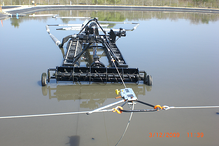The world's largest stormwater alum treatment facility - in Florida
Stormwater in the Florida canal system is slow moving. The green, murky water in the lakes fed by...
SRS Crisafulli has discovered the Rural Water Association. This winter, Troy Fercho, Frank Robinson, Tristan Hoff and I attended shows in North Dakota, Montana, Minnesota, and Idaho. At these Rural Water Association Trade Shows, we promoted SRS Crisafulli's dredge equipment and rental services to assist communities in managing the long term, low cost resource of their wastewater lagoon systems.

When lagoon operators use proven, successful, operating and maintenance procedures, Wastewater Lagoon Plants can get in compliance, and can stay in compliance. Many lagoons have been in service for 30, 40, or 50 years. Lagoons should be desludged every 8 to 10 years for optimum performance.
One of our dredge systems, the remote controlled Flump Dredge System, pictured here, is an electric, unmanned system that is available for sale or can be rented directly by a facility or by a contractor. All of our dredge systems are made in the USA – in Montana to be exact. We provide installation and operator training for dredge sales anywhere in the world, and for rentals anywhere in the USA and Canada.
What have we learned at the Rural Water Shows? One of the high notes of the Great Falls conference was meeting Steve Harris, an independent consultant from Arizona, who has provided lagoon optimization and troubleshooting services for over a decade. Steve gave several presentations on lagoon troubleshooting at the Montana Rural Water Association convention in Great Falls.
How to Upset a Wastewater Treatment Plant
Steve Harris put a little bug in my ear about the impact of methamphetamine laboratories on wastewater treatment lagoons. Quick investigation produced a similar article in the December, 2012 issue of Treatment Plant Operator, by wastewater treatment plant Laboratory Detective, Ron Tygar, entitled, "Knowing What’s Coming." Ron writes: “Industries are not the only sources of discharges that can upset treatment plants. Residential abusers can have big impacts, too.” In his article, Ron, gave two specific examples of residential sewage abusers - deep fat turkey fryers, and methamphetamine labs.
In the first case, residents sometimes face the dilemma of what to do with 7 to 8 gallons of used cooking oil once the Thanksgiving holiday has passed. Some ingenious homeowners have discovered that the 3-inch PVC clean-out cap sticking up in the yard is conveniently connected to the local sewer system.
In the second case, the high levels of waste ammonia discharged into the sewer system along with other hazardous substances create a high-strength, or even toxic waste to the fragile micro-organisms.
Troubleshooting your Lagoon
Steve is the author of Wastewater Lagoon Troubleshooting - An Operators Guide to Solving Problems and Optimizing Wastewater Lagoon Systems. Steve's textbook charts eight general problems in lagoon management:
(1) low dissolved oxygen, (2) toxicity, (3) odors, (4) low temperature, (5) high coliform, (6) high BOD (biological oxygen demand), (7) TSS Control (total suspended solids), and my favorite, (8) “Short Circuiting” which refers to hydraulic inefficiencies that allow wastewater to exit a lagoon over a time shorter than necessary to completely stabilize it.
In terms of the potential value to lagoon operators of a dredging resource, removing sludge scores a 7 out of 8. Steve offers at least five strategies for each of the eight major issues on the way to optimum lagoon performance and compliance.
There are many fine points in managing wastewater systems. Our interest as a supplier of "sludge removal systems" is to support the longevity and efficiency of lagoons as operating systems.
As Steve Harris writes in the preface to his textbook, “The knowledge concerning diagnosing and solving operational problems in wastewater stabilization ponds has been greatly expanded over the last twenty years. Many papers have been published in scientific journals and several excellent books have been written on the subject of wastewater lagoon systems. Years of consulting with lagoon operators across the US, Canada, Mexico and Central and South America has shown me that little of this valuable information ever reaches lagoon operators.”
Another resource that addresses that same knowledge gap is the Maine Lagoon Systems website, which has a mission is to promote clean water resources through the enhanced communication of wastewater lagoon system operators in the state of Maine and beyond. This website provides an online presence in which operators of lagoon systems can network with each other on various issues of wastewater treatment relative to today's demand of a clean water environment.
A technical note from the Maine Lagoon Systems offers the following:
It has been reported that as many as 60 percent of the BOD5 (The amount of dissolved oxygen consumed in five days by bacteria that perform biological degradation of organic matter) violations nationally may have been caused by nitrification in the BOD5 test rather than by improper design or operation (Hall and Foxen 1983). Consequently, millions of dollars may have been spent needlessly on new treatment facilities.
To decide if you too want to meet Steve Harris, a 2009 lecture is available on YouTube.
H&S Environmental is committed to helping you get better performance from the wastewater lagoons you're already using. Their goal is to provide wastewater lagoon operators with practical, easy to use and cost effective tools to solve their toughest wastewater lagoon challenges. H&S Environmental is committed to the belief that wastewater lagoons are capable of producing high quality effluents...effluents that will consistently meet tougher new permit limits. Some of the chief problems with wastewater lagoons are operational, but many lagoon problems are the result of design deficiencies that can be fixed.
To learn more about Lagoon Dredging or to inquire about dredge rentals or purchasing options...
Stormwater in the Florida canal system is slow moving. The green, murky water in the lakes fed by...
The propulsion and traverse systems are critically important to the operation of an unmanned,...
Leave a Comment